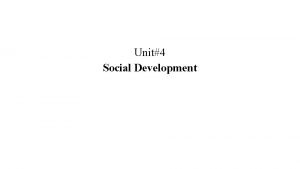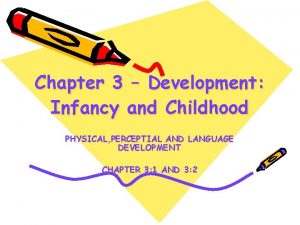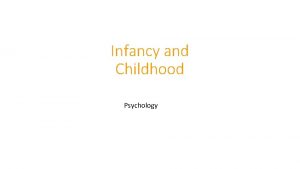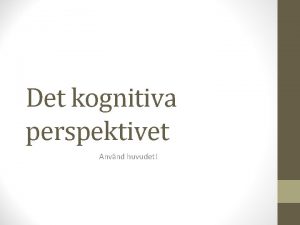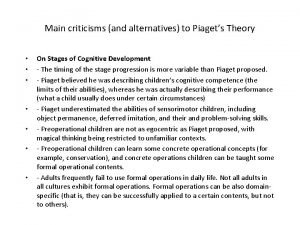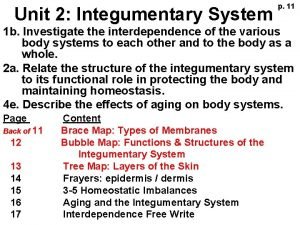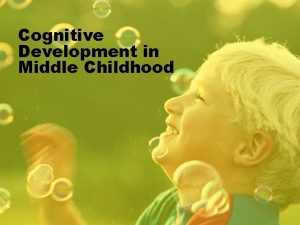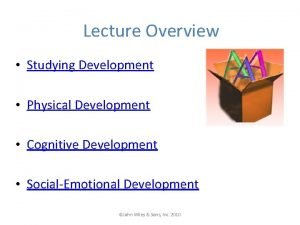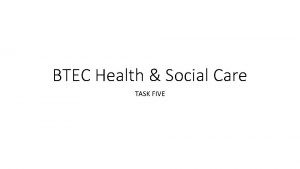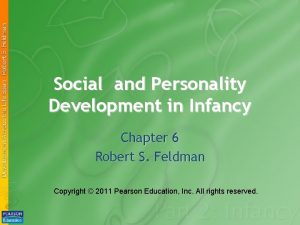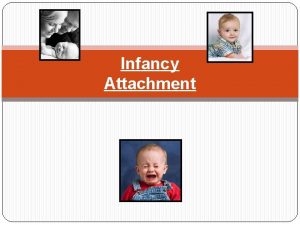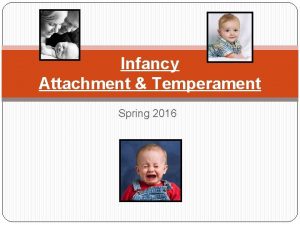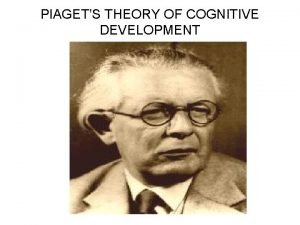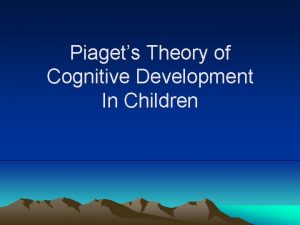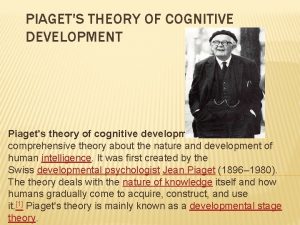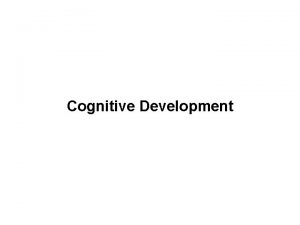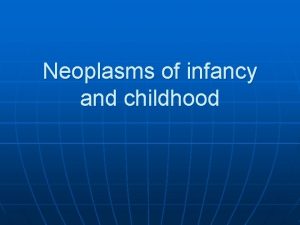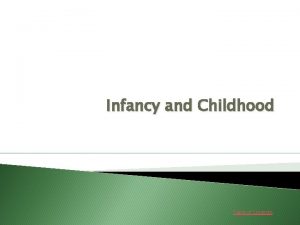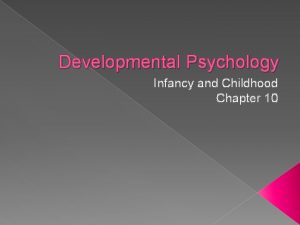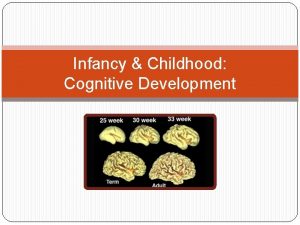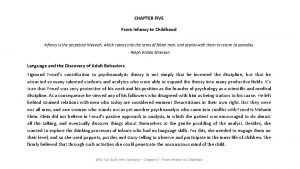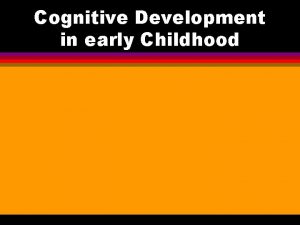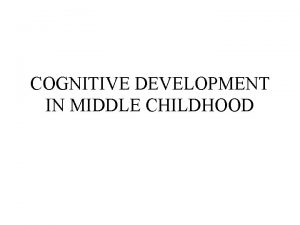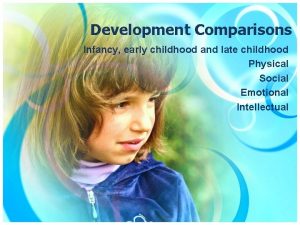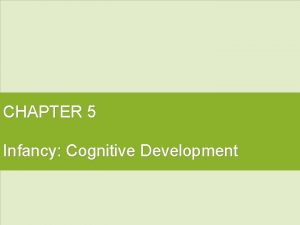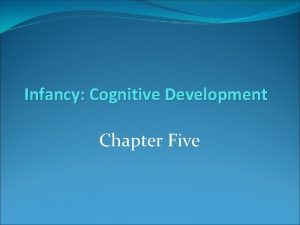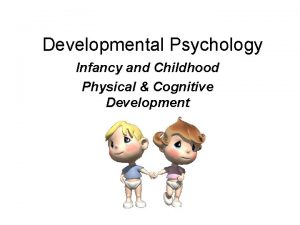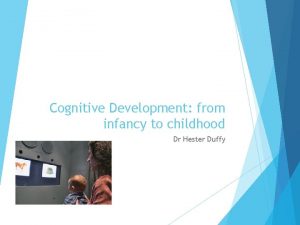Cognitive Development in Infancy and Childhood Piagets Cognitive

























- Slides: 25

Cognitive Development in Infancy and Childhood: Piaget’s Cognitive Stages

Question to ponder Do Kids think differently than adults? Do freshmen think differently than Seniors?

Piaget’s Theory of Cognitive Development • Jean Piaget (1896– 1980) Swiss psychologist who became leading theorist in 1930’s • Piaget believed that “children are active thinkers, constantly trying to construct more advanced understandings of the world” • These “understandings” are in the form of structures he called schemas

Piaget’s Approach • Primary method was to ask children to solve problems and to question them about the reasoning behind their solutions • Discovered that children think in radically different ways than adults • Proposed that development occurs as a series of ‘stages’ differing in how the world is understood

Cognition • All the mental activities associated with thinking, knowing, and remembering • Children think differently than adults

Stage 1 - Sensorimotor Stage • From birth to about age two • Child gathers information about the world through senses and motor functions • Child learns object permanence

Sensorimotor Stage (birth – 2) • Information is gained through the senses and motor actions • In this stage child perceives and manipulates but does not reason • Symbols become internalized through language development • Object permanence is acquired

Object Permanence • The understanding that objects exist independent of one’s actions or perceptions of them • Before 6 months infants act as if objects removed from sight cease to exist – Can be surprised by disappearance/reappearance of a face (peek-a-boo)

Object Permanence • The awareness that things continue to exist even when they cannot be sensed • “Out of sight, out of mind”

Object Permanence

Stage 2 - Preoperational Stage • From about age 2 to age 6 or 7 • Children can understand language but not logic • Fantasy Play

Preoperational 1. Symbolic functioning – is that a child uses to represent something that is not physically present like the use of mental symbols, words, or pictures

Preoperational - Egocentrism • The child’s inability to take another person’s point of view • Includes a child’s ability to understand that symbols can represent other objects

Concrete Operational Stage (7– 12 years) • Understanding of mental operations leading to increasingly logical thought • Classification and categorization • Less egocentric • Inability to reason abstractly or hypothetically

Concrete operational 1. Decentering – this is where a child considers all aspects of a problem to solve it 2. Elimination of egocentrism – kids can begin to see the others point of view

Conservation • An understanding that certain properties remain constant despite changes in their form • The properties can include mass, volume, and numbers.

Conservation

Conservation

Conservation

Conservation • Number In conservation of number tests, two equivalent rows of coins are placed side by side and the child says that there is the same number in each row. Then one row is spread apart and the child is again asked if there is the same number in each.

Conservation • Length In conservation of length tests, two same-length sticks are placed side by side and the child says that they are the same length. Then one is moved and the child is again asked if they are the same length.

Conservation • Substance In conservation of substance tests, two identical amounts of clay are rolled into similar-appearing balls and the child says that they both have the same amount of clay. Then one ball is rolled out and the child is again asked if they have the same amount.

Formal Operational Stage (age 12 – adulthood) • Hypothetico-deductive reasoning • Adolescent egocentrism illustrated by the phenomenon of personal fable and imaginary audience

Stage 4 - Formal Operational Stage • Child can think logically and in the abstract • Can solve hypothetical problems (What if…. problems)

Critique of Piaget’s Theory • Underestimates children’s abilities • Overestimates age differences in thinking • Vagueness about the process of change • Underestimates the role of the social environment • Lack of evidence for qualitatively different stages
 Ap psych schema
Ap psych schema Module 47 infancy and childhood cognitive development
Module 47 infancy and childhood cognitive development Early childhood middle childhood
Early childhood middle childhood Social development in infancy and childhood
Social development in infancy and childhood Infancy and childhood physical development
Infancy and childhood physical development Rovee-collier
Rovee-collier Chapter 5 cognitive development in infancy and toddlerhood
Chapter 5 cognitive development in infancy and toddlerhood Infancy and childhood psychology
Infancy and childhood psychology Psychology chapter 10 infancy and childhood
Psychology chapter 10 infancy and childhood Chapter 10 infancy and childhood review worksheet answers
Chapter 10 infancy and childhood review worksheet answers Chapter 10 infancy and childhood review worksheet answers
Chapter 10 infancy and childhood review worksheet answers Lesson quiz 3-2 infancy and childhood
Lesson quiz 3-2 infancy and childhood Kognetiva scheman
Kognetiva scheman Criticisms of piagets theory
Criticisms of piagets theory Infancy childhood adolescence adulthood old age
Infancy childhood adolescence adulthood old age Late childhood cognitive development
Late childhood cognitive development A vygotskian classroom promotes ________.
A vygotskian classroom promotes ________. Language development in middle childhood
Language development in middle childhood Cognitive development in childhood
Cognitive development in childhood Slidetodoc. com
Slidetodoc. com What is intellectual in health and social care
What is intellectual in health and social care Socioemotional development in infancy
Socioemotional development in infancy Chapter 7 human growth and development
Chapter 7 human growth and development The stage of growth
The stage of growth Personality development in infancy
Personality development in infancy Infants display a wide range of emotional expressions
Infants display a wide range of emotional expressions



